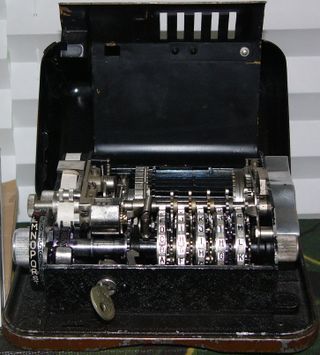
C-36 (cipher machine)
Encyclopedia

Boris Hagelin
Boris Caesar Wilhelm Hagelin was a Swedish businessman and inventor of encryption machines.Born of Swedish parents in the Caucasus , Hagelin attended Lundsberg boarding school and later studied mechanical engineering at the Royal Institute of Technology in Stockholm, graduating in 1914...
in the 1930s. These were the first of Hagelin's cipher machines to feature the pin-and-lug mechanism. A later machine in the same series, the M-209
M-209
In cryptography, the M-209, designated CSP-1500 by the Navy is a portable, mechanical cipher machine used by the US military primarily in World War II, though it remained in active use through the Korean War...
, was widely-used by the United States military.
In 1934, the French
France
The French Republic , The French Republic , The French Republic , (commonly known as France , is a unitary semi-presidential republic in Western Europe with several overseas territories and islands located on other continents and in the Indian, Pacific, and Atlantic oceans. Metropolitan France...
military approached Hagelin to design a printing, pocket-size cipher machine; Hagelin carved a piece of wood to outline the dimensions of a machine that would fit into a pocket. He adapted one of his previous inventions from three years earlier: an adding device designed for use in vending machines, and combined it with the pinwheel mechanism from an earlier cipher machine (the B-21). The French ordered 5,000 in 1935. Italy and the USA declined the machine, although both would later use the M-209 / C-38
M-209
In cryptography, the M-209, designated CSP-1500 by the Navy is a portable, mechanical cipher machine used by the US military primarily in World War II, though it remained in active use through the Korean War...
. Completely mechanical, the C-35 machine measured 6 × 4.5 × 2 inches, and weighed less than 3 pounds.
A revised machine, the C-36, was similar to the C-35, but had a different distribution of the lugs on the bars. Six C-36 machines were purchased by the Swedish Navy
Swedish Navy
The Royal Swedish Navy is the naval branch of the Swedish Armed Forces. It is composed of surface and submarine naval units – the Fleet – as well as marine units, the so-called Amphibious Corps .In Swedish, vessels of the Swedish Navy are given the prefix "HMS," short for Hans/Hennes...
for testing in October 1937. Both machines had five pinwheels with 17, 19, 21, 23 and 25 pins, each individually settable, giving a maximum period of 3,900,225 for the machine. The C-362 revision included a few other improvements, most notably movable lugs instead of fixed.
One variant had a Thai alphabet
Thai alphabet
Thai script , is used to write the Thai language and other, minority, languages in Thailand. It has forty-four consonants , fifteen vowel symbols that combine into at least twenty-eight vowel forms, and four tone marks ....
on the pinwheels, rather than the usual Latin alphabet
Latin alphabet
The Latin alphabet, also called the Roman alphabet, is the most recognized alphabet used in the world today. It evolved from a western variety of the Greek alphabet called the Cumaean alphabet, which was adopted and modified by the Etruscans who ruled early Rome...
.
Further reading
- C. A. Deavours, Solution of C-35 Texts with Partial Key, Cryptologia, 14(2), April 1990 pp162–168.

